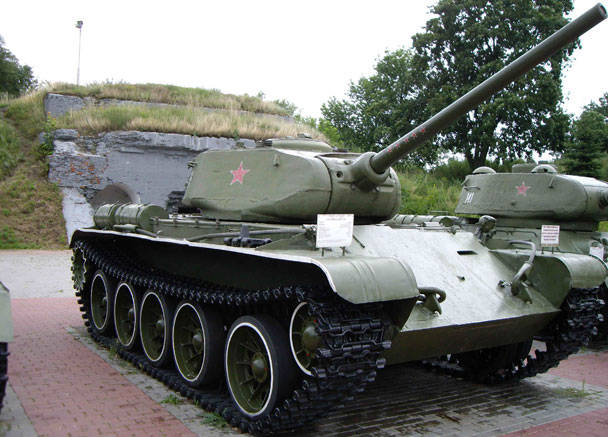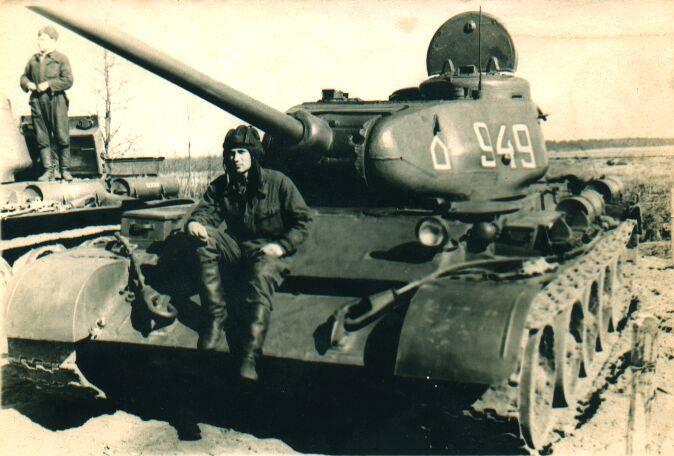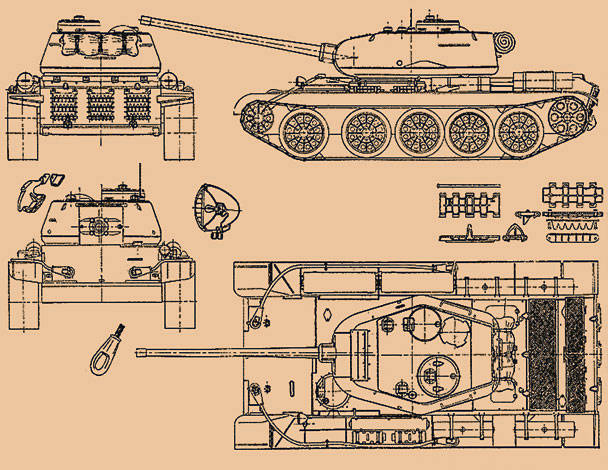The heir to the "thirty-three"
The first circumstance limited the weapons enhancement process: as is known, despite the attempts made, the X-NUMX-mm cannon could not be placed in the T-100-34 either in the standard turret or in the turret with an expanded shoulder strap (and in the latter case it was necessary to make changes in the hull design - shoulder strap with a diameter of 85 mm did not fit into its dimensions). The second made it almost impossible and useless to take any steps to increase the thickness of the frontal armor.
The output was only in the transition to the layout with a different ratio of the internal volumes of the tank or to increase its length. The second solution was refused, and in order to implement the first autumn of 1943 of the year in the design office (department No. 520) of the Ural tank factory No. 183. Stalin (now FGUP “Uralvagonzavod”) in Nizhny Tagil began designing a fundamentally new combat vehicle, which, thanks to the enormous reserves for modernization incorporated in its design, determined the face of post-war Soviet tank construction. In November, the plant director Yu.E. Maksarev and the chief designer A. A. Morozov reported to V. Malyshev the People's Commissar of the Tank Industry indicative characteristics and presented the model of the tank, which received the factory designation “1943 object” and the T-136 index.
Instead of a radio operator, a fuel tank
The developers paid the main attention to the layout of the engine compartment (MTO). To maximize the size of the MTO occupied by the length of the machine, the engine was installed across the hull and connected to the gearbox with a step-up gearbox - the so-called guitar. The height of the MTO was reduced by moving an air cleaner of a new type from the collapse of the cylinders of a V-shaped engine to the board. In place of the fan, speaking for the dimensions of the crankcase, put a compact flywheel. This made it possible to mount the diesel on a low, rigid, but light submotor frame, and as a result, the height of the hull decreased. The engine cooling system radiator was located across the hull, behind the gearbox. As for the fan, it was shifted to the stern sheet, it was brought from the gearbox through the friction clutch, which eliminated the impeller crashes during abrupt changes in engine operation. In addition, this arrangement has significantly improved the cooling of transmission units.
All this made it possible to get the dimensions of the fighting compartment, which allowed for the installation of guns in caliber up to 122 millimeters, and to shift the turret back, so that its axis of rotation almost coincided with the middle of the body. Here his angular oscillations when moving the car were the least. As a result, the accuracy of firing from a tank gun was increased and crew fatigue decreased. Due to the displacement of the tower back on the turret sheet, a place was made for the driver's hatch. The gunner-radio operator was removed from the crew, since the fire from the gun was ineffective due to poor visibility. Meanwhile, after transferring the radio station to the turret and transferring the functions of the radio operator to the tank commander, which was already done on the T-34-85, the gunner-radio operator did not perform any other duties than firing. In its place, put the fuel tank and placed the ammunition for the gun. From bulky nadgusenichnyh niches abandoned.

In the chassis used torsion bar suspension. Tracks on the new car remained the same as on the T-34, with a ridge engagement.
The first prototype of the T-44 tank was developed in December 1943 - January 1944. The car had tons of 30,4. Due to the compact layout of the MTO, it was possible to increase the length of the combat compartment by 430 millimeters, and the height by 210. The thickness of the armor of the upper front hull sheet reached 75 millimeters, the upper side sheet, located vertically, 45 millimeters, it was additionally protected by the 30-mm patch armor sheet. The forehead of the tower had a thickness of 90 millimeters. The tank was fitted with a B-2 diesel with horsepower 500.
Three prototypes were manufactured at the factory number 183 in January-February 1944. The armament of tanks 1 No. and 2 consisted of a 85-mm D-5T cannon and a DT machine gun paired with it. The second DT machine gun was rigidly mounted in the upper front hull plate. Prototype # 3, or T-44-122 equipped 122-mm gun D-25-44, specially designed for it at the factory number 9. It differed from the D-25T serial cannon by the shot power reduced by 2 – 4, by the smaller mass of the sliding parts and by the unitary loading. On tanks No. 1 and No. 3, the diameter of the tower shoulder in the light was 1800 millimeters, and on tank No. 2 - 1600 millimeters. The second number from February 19 to March 5, 1944, was tested at NIBTPolygon, during which many design flaws were revealed. After their elimination in May, two T-1944 tanks of the second modification were manufactured by 44. One of them was tested on NIBTPolygon in June-July 1944. In August-September, a prototype of the third modification, T-44A, was created and subjected to factory tests in the area of Nizhny Tagil and Sverdlovsk.

This tank after making some changes 23 November 1944, the year adopted. 18 July 1944-go issue of the State Defense Committee on the organization in Kharkov of the tank plant number 75 NKTP for the production of 300 machines T-44 per month. He passed all the shops and equipment, surviving from the two pre-war factories - № 183 and № 75. At the same time, a decision was made to relocate to Kharkiv and to include the collective and equipment of the plant No. 75 from the city of Kirov into the plant number 38. The first five serial machines left the shops of the Kharkov enterprise in November of the same year. 1944 tanks were made in 25, 1945 were made in 880, and just before the production was completed in 1947, the army received X-NUMX T-1823 vehicles.
In the battles did not participate
The serial medium tank T-44 had a welded hull with vertical sides, 75 millimeters thick. The frontal 90-mm sheet was located at an angle 60о from the vertical. The frontal armor of the cast turret was 120 millimeters. The driver was located in the left front of the hull. Above his workplace there was a landing hatch with a lid rotating on a ball support. To observe the battlefield and driving the car, the MK-4 device was located on the basis of the internal opening of the manhole cover, there was a triplex viewing slot in the front hull sheet, and a prism viewing instrument was installed in the left hull side sheet. A cast low-profile commander's cupola with five observation slots along the perimeter was welded into the roof of the tower. To the right of the turret in the roof of the tower was mounted loader round landing door. In the roof of the tower were placed two devices MK-4, and another one - in the rotating roof of the commander's turret.

In the embrasure of the frontal part of the turret there were a 85-mm ZIS-С-53 cannon and a DTM machine gun paired with it. The vertical alignment angles of this paired installation ranged from -5о to + 20о. For aiming firing of guns and machine guns used telescopic articulated sight TSH-15, and then - TSH-16 with an enlarged field of view and a new reticle of the sight. For firing from closed positions on the left shield of the cannon fences placed side level.
Another DTM machine gun was rigidly mounted in the upper front hull of the tank hull. A mechanic-driver shot him, pushing the electric release button mounted in the right-side friction control lever.
The ammunition of the tank included 58 artillery shots and 1890 cartridges for machine guns. The main part of the gun ammunition (30 shots) was in the right fore part of the tank hull in a special rack. Another 10 shots were located on the sides of the hull, 18 - in the tower, of which 16 were located in a niche.
12-cylinder diesel four-stroke V-shaped engine B-44 liquid cooling horsepower 500 (368 kW) at 1800 rpm was located across the body. The engine power system consisted of four fuel tanks with a total capacity of 500 liters. In addition, three spare fuel tanks with a capacity of 50 liters each, which were not connected to the power supply system, were installed on the fences on the shelves.
The transmission of the tank consisted of a “guitar” (gearbox of three cylindrical gears), a multidisk main dry-friction clutch, a five-speed gearbox, two multi-disc side clutches with floating belt brakes and two onboard gears. The transmission had a power take-off mechanism for driving the engine cooling fan.
The chassis, as applied to one board, included five rubber-cast cast-on rollers, a rear drive drive wheel (gearing), a steering wheel, an individual torsion suspension, each track has 70 tracks 500 millimeters wide, and a track step 172 millimeters.
The engine, transmission and running gear provided the 31,8-ton combat vehicle with maximum speed of 51 km / h. Cruising reached 300 kilometers, on the internal fuel tanks - 235 kilometers. The crew of the tank - four people.
The receiving and transmitting shortwave simplex telephone radio station 9PC was used for the external communication on the machine. Intercom system was used intercom TPU-3-bisf.
It should be noted that despite the successful development in the army of new tanks, they did not go to the front and did not participate in the hostilities of the Second World War. The fact of tests of T-44 in front-line conditions is also unknown. However, preparations for the appearance in the army of new armored vehicles began in 1944. To provide, for example, command personnel of units and formations armed with these tanks, three schools were formed by 15 September 1944 of the year:
Guards Kharkov tank based on the 33-th Guards Tank Brigade;
Guards Sivash Red Banner Tank based on the 6-th Guards Tank Brigade;
Guards Taman tank based on the 63 of the Taman Tank Brigade.
The number of variable composition for each of these schools - over a thousand cadets.
Several modifications
Soon after the start of mass production, in the spring and summer of 1945, experimental work was carried out to enhance the firepower of the T-44. On two samples of T-44-100, X-NUMX-mm D-100T and LB-10 guns were tested. The tests of the D-1T machine gun failed: the tank was swaying during shots, which made the tip-off, after intensive firing, a backlash in the tower chase finally failed to balance the gun properly. The T-10-44 with the LB-100 cannon had a anti-aircraft turret with a large-caliber DShK machine gun and mounted side screens of the German type. His tests ended with the best result, but the military was not satisfied with the gun having a muzzle brake. Neither one nor the other tank was adopted.
T-44 was a kind of transitional model to the medium tank T-54. First of all, tank units equipped with Thirty-Fours were the last to re-equip, so for some time the T-44 and T-54 were operated by the troops simultaneously. Contributed to this and the modernization of the "forty-fourth." In 1961, the units of the power plant, transmission and chassis T-44 were unified with those on the T-54. The B-44 engine was replaced by a B-54, the capacity of the fuel tanks increased, and the cruising range increased. Instead of the side clutches, two-stage planetary rotation mechanisms were introduced. In the undercarriage, the tracked propulsor of the pinching gear began to be used, new stamped track rollers appeared. The hull, tower and tank armament remained without significant changes. Ammunition gun increased to 61 shot. TVN-2 night mechanic device and Р-113 radio station were installed. This machine has received the brand T-44M.
In 1963, on the basis of the T-44M tank, a commander tank T-44MK was created. It was equipped with two radio stations P-112 and P-113. Installing additional radio equipment led to a decrease in ammunition for 15 shots and 441 cartridge, as well as the removal of the course gun.
In 1966, the T-44M was equipped with a two-plane weapon stabilizer. This machine has received the index T-44C.
The upgraded tanks remained in the Soviet army until the 80-s and were operated mainly in training units. The vehicles that did not undergo modernization were converted into armored tractors BTS-4, and also sent to fortified areas. In particular, using a turret with armament T-44, a long-term firing point in the Group of Soviet Forces in Germany was developed. In addition to the tank tower, it included a set of reinforced concrete structures, which was transported on trucks. All this could be delivered to the necessary place, where the foundation pit was torn off and the calculation room was assembled, an emergency exit gallery and a vertical shaft-well surmounted by a tank tower. After assembly, the pit, of course, fell asleep.
In conclusion, it will be curious to note that the tank, which has never fought anywhere, has managed to "distinguish itself" in the fighting on the silver screen. We are talking about the movie "On the roads of war" (1958), which filmed at least two dozen T-44 (and it was T-44 with the ridge engagement of the tracks). Images from this tape are used in one of the final scenes of the popular drama "Officers" (1971) to this day. In the episode in the vineyard in the film "Father of the Soldier" (1964) there are already T-44M. However, the forty-fourths made the most notable contribution to the national cinema, playing the roles of “Tigers” in the epic “Liberation” (1968 – 1971). Several T-44M talented enough "dressed" in heavy German tanks. And on the silver screen, the substitution was immediately difficult to determine. The dimensions of the car were hidden by shooting under the appropriate angles, and the running gear, which rarely got into the frame at all, could only be seen during the second or third viewing. "Psevdogigry" were filmed in the cinema and in the next 10 – 15 years, apparently, to complete wear of the basic machines. In any case, at the military-technical base of "Mosfilm" they are long gone.
Information